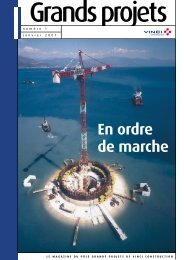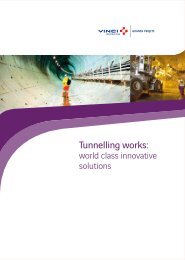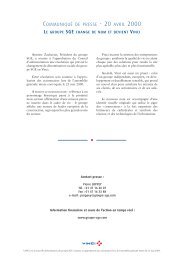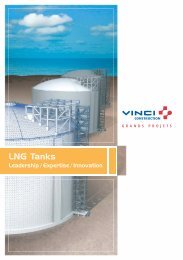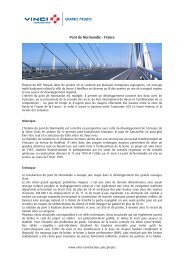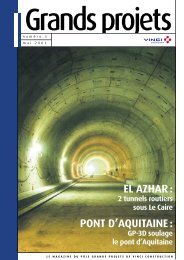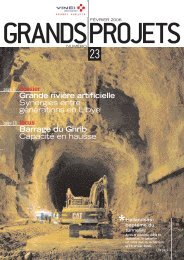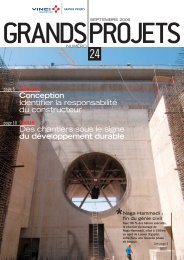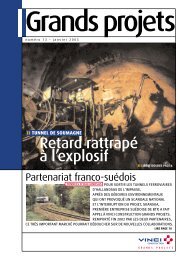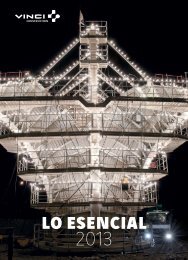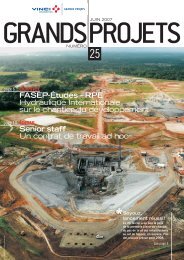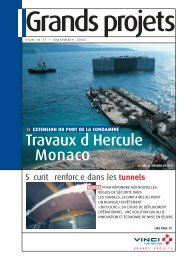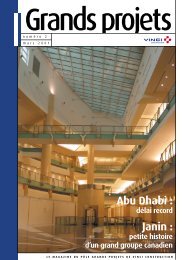barrage naga hammadi - VINCI Construction Grands Projets
barrage naga hammadi - VINCI Construction Grands Projets
barrage naga hammadi - VINCI Construction Grands Projets
Create successful ePaper yourself
Turn your PDF publications into a flip-book with our unique Google optimized e-Paper software.
NAGA<br />
HAMMADI<br />
BARRAGE<br />
Harnessing the forces of the Nile for the coming century<br />
grands projets
The players behind the project<br />
The Clients: The Naga Hammadi <strong>barrage</strong> was commissioned<br />
by the Arab Republic of Egypt’s Ministry of Water<br />
Resources and Irrigation, and Ministry of Electricity and<br />
Energy, advised by a group of consultants comprising<br />
Lahmeyer International (Germany), Electrowatt (Switzerland)<br />
and Sogreah (France).<br />
Funding was provided by the Egyptian government, with<br />
financing by the European Investment Bank and the<br />
German Entwicklungsbank, KfW.<br />
The Contractors: <strong>VINCI</strong> <strong>Construction</strong> <strong>Grands</strong> <strong>Projets</strong><br />
(leader), Bilfinger Berger and Orascom <strong>Construction</strong> Industries,<br />
acting in Joint-Venture, were awarded the civil<br />
works contract.<br />
<strong>VINCI</strong> <strong>Construction</strong> <strong>Grands</strong> <strong>Projets</strong><br />
(France) designs and builds major civil<br />
engineering structures and buildings<br />
throughout the world. The company<br />
combines its engineering and project<br />
management expertise with the<br />
proactive creation of local partnerships<br />
when deploying solutions for its public<br />
and private-sector clients.<br />
Bilfinger Berger (Germany) is<br />
a leading international construction<br />
and service company. As a Multi Service<br />
Group, Bilfinger Berger delivers<br />
comprehensive solutions in the areas<br />
of real estate, infrastructure and industrial<br />
services. Its business activities range<br />
from consulting, development, design,<br />
financing and turnkey construction<br />
through to operation and maintenance.<br />
Orascom <strong>Construction</strong> Industries<br />
(Egypt) provides engineering,<br />
procurement and construction services<br />
on large-scale infrastructure, industrial<br />
and commercial projects principally<br />
across the Middle East, North Africa<br />
and Central Asia. OCI is a leader<br />
in the regional construction market.
A multi-purpose structure<br />
Irrigation: the new dam (3.5 km downstream from<br />
the original dam) was designed to increase the existing<br />
irrigation system, a task for which rehabilitation of the<br />
previous 80-year-old structure was deemed insufficient.<br />
By raising the level of the Nile upstream by approximately<br />
one meter, the new <strong>barrage</strong> irrigates 60,000 additional<br />
hectares for agriculture land.<br />
Regulation of the Nile: the new Naga Hammadi<br />
<strong>barrage</strong> will manage regular seasonal variations in the<br />
river’s level, as well as cope with the maximum<br />
emergency output if the Aswan dam were to be opened<br />
upstream (7,000 m 3 /second).<br />
Electricity production: four turbines with total output<br />
of 64 MW enough to power 200,000 Egyptian households<br />
with environmentally friendly, renewable energy.<br />
Increased shipping capacity: two high capacity<br />
navigation locks accommodate even the largest Nile<br />
cruise ships, carrying visitors to Luxor and the other sites<br />
of Upper Egypt.<br />
7,000 m 3 /second<br />
maximum flow capacity<br />
200,000<br />
households powered<br />
with clean hydroelectric energy<br />
60,000 ha<br />
of additional agricultural land<br />
NAGA HAMMADI - 3
A force for regional<br />
development<br />
CAIRO<br />
LUXOR<br />
Naga <strong>hammadi</strong><br />
ASWAN<br />
The Nile river valley is Egypt’s breadbasket and home<br />
to 97% of the country’s population, although the site<br />
chosen for construction of the new <strong>barrage</strong> is itself very<br />
isolated. Naga Hammadi lies in Upper Egypt, about midway<br />
between Aswan, upstream to the South, and Cairo,<br />
some 500 km distant to the Nile river delta.<br />
The Naga Hammadi Barrage has major regional impact<br />
by increasing land available for cultivation, providing<br />
clean energy and improving floodwater regulation.<br />
The Egyptian Clients also wanted the project itself to contribute<br />
to local added value and economic development.<br />
The Joint-Venture partners worked closely with local<br />
staff and labourers to ensure positive impact on the<br />
natural and economic environment of the region. An<br />
awareness campaign directed by the Ministry of Water<br />
Resources and Irrigation towards the local population<br />
provided information about the many benefits to be<br />
provided by the new dam.<br />
Workers from the local sugar cane farming operations<br />
were trained as the main source of manpower<br />
for the project, which employed close to 2,000 workers<br />
during peak phases, most coming from the surrounding<br />
villages. A dedicated transport service by bus and boat<br />
brought workers to the construction site.<br />
Land which was temporarily reclaimed for construction<br />
of the diversion canal and other project elements was<br />
renaturalized before restoration to farmers.<br />
Certain specific activities have been sub-contracted<br />
to local companies such as Arab Contractors (dredging<br />
and riverbed protection), Bauer Egypt (diaphragm walls),<br />
Bekheet and Awad (earthworks), Rowad (steel reinforcement)<br />
and Harb (Electromechanical).<br />
Specific design and operating measures were implemented<br />
to protect groundwater quality and prevent Nile<br />
River from soil pollution.<br />
2,500<br />
local jobs created
Strong technical expertise and complex logistics<br />
The Clients awarded contracts in packages corresponding<br />
to the technical expertise required for the various<br />
facets of the dam’s construction:<br />
Diversion canal and cofferdam,<br />
Civil engineering for the <strong>barrage</strong> structures,<br />
Hydromechanical and electrical equipment,<br />
Permanent housing and operation services building.<br />
The civil works Joint-Venture comprising <strong>VINCI</strong><br />
<strong>Construction</strong> <strong>Grands</strong> <strong>Projets</strong> / Bilfinger Berger / Orascom<br />
<strong>Construction</strong> Industries handled all these works except<br />
equipment.<br />
Cofferdam: a 1,650 m circular cofferdam reinforced<br />
with diaphragm walls of plastic concrete to a depth of up<br />
to 59 m was designed to withstand any tensions resulting<br />
from drainage, excavation and construction, without<br />
loss of waterproof properties.<br />
Barrage structures: the 336 m length dam includes:<br />
- the sluiceway with seven bays, each 17 m in width,<br />
- dual 17 m x 160 m navigation locks,<br />
- the hydroelectric plant housing four turbines and<br />
generators.<br />
The Joint-Venture delivered multiple structures on a<br />
tight deadline.<br />
Diversion canal: full diversion of the Nile river is a<br />
procedure only used once before, during construction<br />
of the Aswan dam. 3.1 million m 3 of earth were removed<br />
through dry excavation and dredging of the right<br />
bank. The canal bed was reinforced with 300,000 m 2 of<br />
geotextile and a 200,000 m 3 stone layer, to withstand<br />
erosion even under strong current.<br />
NAGA HAMMADI - 5
<strong>Construction</strong><br />
phases<br />
1. Diversion canal<br />
(June 2002 – Dec. 2003)<br />
Situation with cofferdam and sealing element<br />
Measuring 1.1 km in<br />
length, 10 m deep with a<br />
minimum navigable width of<br />
100 m, the canal served to<br />
divert the Nile in full for the<br />
duration of the project with no<br />
disruption in fluvial transport.<br />
Shipping was transferred to<br />
the canal in October 2003.<br />
After finishing structures within the pit<br />
6.6<br />
million m 3 of earth removed<br />
Final stage
Cofferdam<br />
<strong>Construction</strong> pit<br />
Diversion canal<br />
2. Cofferdam and<br />
construction pit<br />
(Nov. 2003 – Nov. 2004)<br />
Cofferdam reinforced with excavation<br />
of the plastic concrete cut-off walls created<br />
a construction pit on the bed of the Nile.<br />
Measuring 240,000 m 2 and 1,815 m in<br />
circumference, the pit was fully drained<br />
including lowering of ground water levels,<br />
to prepare the riverbed surface for the<br />
next phase.<br />
NAGA HAMMADI - 7
<strong>Construction</strong><br />
phases<br />
3. Concrete<br />
structures<br />
(Dec. 2004 – Oct. 2006)<br />
The main concrete<br />
structures were completed on a<br />
tight deadline, 18 months from<br />
start to finish. Meeting this<br />
schedule required proactive<br />
team management and careful<br />
logistical planning, to achieve a<br />
high daily cadence of 1,000 m 3 .<br />
400,000<br />
m 3 of concrete poured
4. Impounding<br />
(Oct. 2006)<br />
The construction pit was refilled following completion<br />
of the <strong>barrage</strong>, using pumps for a controlled impounding<br />
to avoid erosion of the cofferdam walls before their<br />
removal. Once the new locks were opened to navigation<br />
(February 2007), backfill of the diversion canal and<br />
construction of service buildings completed the project,<br />
on schedule in May 2008.<br />
NAGA HAMMADI - 9
Specific<br />
characteristics<br />
The Joint-Venture successfully<br />
negotiated the multiple strategic<br />
and technical challenges imposed<br />
by the nature of the project and the<br />
requirements of the Clients.<br />
Extremely tight calendar:<br />
63 key dates over 2 years imposed<br />
by the Clients to ensure coordination<br />
of the project lots.<br />
Rapid pace of concrete work:<br />
25,000 m 3 of concrete in average<br />
per month, during the 8 months<br />
peak period.<br />
<strong>Construction</strong> of the <strong>barrage</strong><br />
in a single piece on the riverbed,<br />
without disruption to Nile<br />
shipping.<br />
High density of reinforcement<br />
steel: 48,000 tons required for a<br />
confined space necessitated expert<br />
engineering.<br />
Curved geometry, in particular of<br />
the powerhouse inflow and outflow<br />
structures, required complex and<br />
technically challenging formwork<br />
(265,000 m 2 of formwork in all).
NAGA HAMMADI - 11
Specific<br />
characteristics<br />
Significant engineering design<br />
modifications introduced by the<br />
Consultant after start of construction,<br />
requiring the rapid implementation of<br />
additional equipment and manpower.<br />
Environmental protection:<br />
measures to maintain groundwater<br />
quality, renaturalization of farmland,<br />
etc.<br />
Regional added value: local<br />
manpower used for the bulk of the<br />
work, requiring specific, intensive<br />
training programmes. Small<br />
management teams from Cairo, local<br />
staff and labourers.<br />
Logistics: transport of materials to<br />
the site’s remote location took<br />
several days.<br />
Weather conditions: temperatures<br />
more than 40°C during the summer<br />
months required the use of a special<br />
cooling system and ice flake to<br />
maintain the concrete at a<br />
temperature not exceeding 25°C.
NAGA HAMMADI - 13
NAGA HAMMADI - 15
grands projets<br />
08/09 - 2000 copies - Photos: Cyrille Dupont, Thierry Duvivier/Trilogi’c, Francis Vigouroux, photo libraries of <strong>VINCI</strong><br />
and subsidiaries, all rights reserved - Design and layout:



